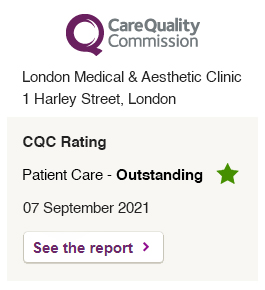A migraine is a very common medical condition and there are different types of treatments to help patients to get rid and to prevent migraine attacks. Anti-Wrinkle Injections is one of the effective treatments and it is a prescription medicine that is injected to treat and prevent chronic migraines.
There are several different types of Anti-Wrinkle Injections (A, B, C, E, F).The Anti-Wrinkle Injections used for cosmetic purposes is the Type A Botulinum or BTX-A.
Anti-Wrinkle Injections is used as a treatment for various conditions involving muscle spasms, and is available in several formulations. One of these (Anti-Wrinkle Injections) has been licensed in the UK for the prevention of headaches in adults with chronic migraines.
Dr Ayham Al-Ayoubi: “Anti-Wrinkle Injections has been commonly used for many years, as a cosmetic procedure used to treat facial lines and wrinkles. It was originally designed to treat muscle spasms but it was also found that it helps migraine sufferers”.
Plastic surgeons first found that Anti-Wrinkle Injections could help tame migraines when patients treated cosmetically with Anti-Wrinkle Injections noticed that their migraines had improved. It is also an effective treatment for some cases of depression.
Anti-Wrinkle Injections for Migraines
There are many different types of headaches. A migraine is a type of headache where the person often has an intense throbbing headache and additional symptoms such as nausea, vomiting or increased sensitivity to bright light, noise or smell.
There are two recognised forms of migraine. A migraine is often described as a classic migraine with ‘aura’ if the person gets some form of visual distortions prior to the headache. These visual distortions are often in the form of zigzag or flashing patterns across their vision. Non-classic or common migraines do not have this aura.
Migraines are thought to be caused by changes in the chemicals of the brain, in particular serotonin. Serotonin levels are believed to decrease during a migraine, which can cause the blood vesels in the brain to spasm and then dilate, causing the headache. Other triggers can be: hormonal changes, certain food items, environmental situations, emotions, stress and physical triggers (for example muscular tension or poor sleep).
Acute migraines are usually treated using painkillers and anti-sickness medications. For people whose migraines do not respond to over-the-counter medications, stronger painkillers may be prescribed by a doctor. If a person suffers from regular debilitating migraines they may need to be prescribed preventative (prophylactic) medications, which they take to stop them getting migraines. There are various drugs currently prescribed for migraine prophylaxis, including beta-blockers and certain antidepressants or anticonvulsants.
Anti-Wrinkle Injections is a prescription medicine that is injected to prevent headaches in adults with chronic migraines, who have fifteen or more days each month with headaches lasting for four or more hours each day in people 18 years or older.
Anti-Wrinkle Injections is a purified neurotoxin derived from the bacterium clostridium botulinum. It works by paralysing the nerve supply to muscles, thereby restricting their movement.
To treat chronic migraines, Anti-Wrinkle Injections is injected every twelve to sixteen weeks to specific sites around the head, neck and upper back, to try to weaken and dull future headache symptoms.
Anti-Wrinkle Injections works by effectively ‘relaxing’ the muscle in the treated area. Its beneficial effects for migraines are thought to be because it relaxes the muscles where most tension is present.
Anti-Wrinkle Injections have been shown to be highly effective in preventing headaches, nausea and dizziness associated with chronic migraines that afflict hundreds of thousands of people every year. Anti-Wrinkle Injections works by temporarily relaxing the muscles in the forehead and neck, blocking the nerve connections, as well as, being a muscle relaxant, Anti-Wrinkle Injections may also be effective at blocking pain signals.
Clinical trials indicate that on average, Anti-Wrinkle Injections treatment will reduce the frequency of migraines by about 50 per cent. For people who are having migraines virtually every day, this can make an enormous difference to the quality of their lives.
Sufferers of chronic migraine have found that Anti-Wrinkle Injections not only reduces the number of migraines they suffer it also makes the ones they have get less severe and easier to manage.
Acute migraines are usually treated using painkillers and anti-sickness medications. For people whose migraines do not respond to over-the-counter medications, stronger painkillers may be prescribed by a doctor. If a person suffers from regular debilitating migraines they may need to be prescribed preventative (prophylactic) medications, which they take to stop them getting migraines.
There are various drugs currently prescribed for migraine prophylaxis, including beta-blockers and certain antidepressants or anticonvulsants.
To treat chronic migraines, Anti-Wrinkle Injections is injected every twelve to sixteen weeks to specific sites around the head, neck and upper back, to try to weaken and dull future headache symptoms.
These are the main areas where tension builds up which can lead to a migraine. The reduction in muscle tension also produces less strain upon the nervous system which also helps migraine attacks.
Anti-Wrinkle Injections has been shown to reduce pain in a number of disease states, including cervical dystonia, neuropathic pain, lower back pain, spasticity, myofascial pain and bladder pain. Anti-Wrinkle Injections is believed to inhibit the release of peripheral nociceptive neurotransmitters, which may then have a knock-on effect on the central pain processing systems that generates migraine headaches.
Types of Anti-Wrinkle Injections
There are several different types of Anti-Wrinkle Injections (A, B, C, E, F).The Anti-Wrinkle Injections used for cosmetic purposes is the Type A Botulinum or BTX-A.
Anti-Wrinkle Injections of type A is marketed under the names of Anti-Wrinkle Injections, Anti-Wrinkle Injections-Cosmetic (USA) and Vistabel® (Europe) by Allergan Laboratories and under the name of Dysport® by the Ipsen-Biotech Laboratory.
Anti-Wrinkle Injections and Dysport® are the specialities used in medical indications (ophthalmology, neurology, and otorhinolaryngology). Vistabel® and Anti-Wrinkle Injections-Cosmetic are the specialities of the Allergan laboratory which obtained the marketing authorization (A.M.M and FDA approvals) for wrinkle correction, but their action is exactly identical to that of Anti-Wrinkle Injections.
Anti-Wrinkle Injections is one of the many trade names for the neurotoxic protein, called Anti-Wrinkle Injections that is produced by the bacterium clostridium botulinum. In large doses, the protein causes botulism, a rare paralytic illness often linked to food poisoning, however, the protein is used in cosmetic medicine to treat moderate to severe brow furrow (glabellar lines), uncontrolled blinking, lazy eye, wrinkles and upper facial creases. These procedures use a small amount of diluted Anti-Wrinkle Injections that enables controlled weakening of muscles.
Anti-Wrinkle Injections is sold commercially under the brand names Anti-Wrinkle Injections, BTXA, Dysport, Myobloc, Neurobloc, Xeomin, Anti-Wrinkle Injections Cosmetic, and Vistabel.
Anti-Wrinkle Injections is widely used for non-cosmetic medical procedures.
The Treatment
Anti-wrinkle injections are injected with a fine needle into specific muscles with only minor discomfort. A topical ice pad should be applied to the skin to decrease the sensation of the injection. It generally takes between two to fourteen days to take full effect and it is best to avoid alcohol and exposure to excessive sunlight at least five days prior to treatment. Aspirin should be stopped two weeks before treatment in order to reduce bruising.
A few simple measures may optimise the safety and improve the results of treatment. To minimise the risk of later bruising, it is recommended that patients discontinue any non-essential medications or dietary supplements that can cause thinning of the blood:
Aspirin (2 weeks prior)
Non-steroidal anti-inflammatory medications (ibuprofen, naproxen, etc)
Fish oil supplements
Vitamin E
Gingko and ginseng
Red wine
Some patients may have headaches for a few hours after the treatment. They should take care not to rub or massage the treated areas, as this can cause the toxin to migrate to a different area of the face. If this occurs, temporary facial weakness or drooping is possible.
Recommendation is to schedule treatments about every 6 months to help maintain a consistent appearance in the first year. From then on treatment can be delayed by a few months each time as wrinkles have become less apparent.
Anti-Wrinkle Injections Medical Use
In addition to cosmetic use, Anti-Wrinkle Injections is used to treat: cervical dystonia, writer’s cramp, excessive sweating, achalasia (an esophagus problem), chronic pain, neuropathy, and migraine headaches.
For people with overactive bladders, Anti-Wrinkle Injections can improve their quality of life, say researchers from King’s College London School of Medicine, London, England. Anti-Wrinkle Injections administered to the bladder is as good as prescribed medications for tackling urinary urgency and twice as effective in eliminating symptoms completely.
Men with enlarged prostates benefit from Anti-Wrinkle Injections injections directly into the prostate, a study at University Medical College, Taiwan found.
Anti-wrinkle injection – Anti-Wrinkle Injections works by blocking the signals from the nerves to the injected muscles. The muscles can no longer contract strongly, which causes the wrinkles to relax and soften. It is most often used on forehead lines, laughter lines and frown lines.
Anti-wrinkle injection is a naturally occurring substance. It can be used as an effective and powerful medication.
Most patients require further treatments to remove wrinkles and lines as they begin to reappear, but after each injection the wrinkles return less severe, as the muscles are trained to relax.
Researchers discovered in the 1950s that injecting overactive muscles with minute quantities of Anti-Wrinkle Injections, would result in decreased muscle activity by blocking the release of acetylcholine from the neuron by preventing the vesicle where the acetylcholine is stored from binding to the membrane where the neurotransmitter can be released. This will effectively weaken the muscle for a period of three to six months.
Anti-wrinkle injection treatment areas may include: frown lines between the eyebrows and on the bridge of the nose, squint lines (Crow’s-feet) at the corners of the eyes and forehead creases. Not all facial wrinkles benefit from anti-wrinkle injections. Anti-wrinkle injection won’t reverse wrinkles caused by sun damage. Also, it’s less desirable to treat the lines around your mouth because muscles in this area are needed for eating and talking.
The skin type, skin thickness and degree of wrinkling all play a role in determining whether these injections are effective or not.
Patients should only get anti-wrinkle injections in a clinic by a doctor. They should never share a tube of anti-wrinkle injection. Anti-wrinkle injections should be performed by doctors who are experts in skin care and facial anatomy.
A typical visit usually takes 30 minutes, with a slightly longer visit in the case of a first-time patient as lengthier discussion is needed to explain the procedure and its possible side effects.
The early clinical studies indicate that the duration of the treatment benefits is increased over time, so that you should require fewer injections in the future. The duration of the effect varies from patient to patient and may be less effective for those over 65 years of age.
Anti-Wrinkle Injections for Cosmetic Use
The cosmetic effect of Anti-Wrinkle Injections on wrinkles was originally documented by a Plastic Surgeon from Sacramento, California, Dr. Richard Clark, and published in the journal Plastic and Reconstructive Surgery in 1989.
Canadian husband and wife ophthalmologist and dermatologist physicians, JD and JA Carruthers, were the first to publish a study on Anti-Wrinkle Injections for the treatment of glabellar frown lines in 1992. Similar effects had reportedly been observed by a number of independent groups (Brin, and the Columbia University group).
After formal trials, on April 12, 2002, the FDA announced regulatory approval of Anti-Wrinkle Injections to temporarily improve the appearance of moderate-to-severe frown lines between the eyebrows (glabellar lines). Subsequently, cosmetic use of Anti-Wrinkle Injections has become widespread, with many people viewing it as less intrusive and/or artificial than other types of plastic surgery
Also Anti-Wrinkle Injections was approved for the treatment of excessive sweating in the United Kingdom in July 2001.
Anti-Wrinkle Injections Safety
Anti-Wrinkle Injections were licensed specifically for the treatment of chronic migraine in July 2010, by The MHRA in the UK (Medicines and Healthcare Products Regulatory Agency). It has not been shown to be effective for any other headache types, e.g. episodic migraine, tension-type headache, cluster headache) as yet.
Also, Anti-Wrinkle Injections injections are FDA (U.S. Food and Drug Administration) approved for preventive treatment for chronic migraines.
A review from The American Medical Association demonstrated that Anti-Wrinkle Injections – can benefit patients who have chronic migraines, but it does not help those who have episodic migraines or chronic tension-type headaches.
The drug has been used in medicine for almost 50 years. There are approximately 1,800 published studies about it, making it one of the best-researched medicines ever. Dosages used to treat children with cerebral palsy may range from 100 to 400 units, whilst typical dosage for cosmetic use is 20-50 units.
The safety of Anti-Wrinkle Injections is clear , however, some patients may experience side effects; the most common being, temporary bruising at the site of injection, headaches, which resolve in 24-48 hours, Inappropriate facial expression, such as drooping eyelid, uneven smile, or loss of the ability to close the eyes. This will wear off in around two- six weeks.
Other adverse events from cosmetic use include headaches, dysphagia, flu-like syndromes, blurred vision, double vision, dry mouth, fatigue, allergic reactions and swelling or redness at the injection site.
Individuals who are pregnant, have egg allergies or a neuromuscular disorder are advised to avoid Anti-Wrinkle Injections.
Patients rarely develop eyelid drooping. This development is usually caused by migration of the anti-wrinkle injection and for this reason, you shouldn’t rub the treated area for twelve hours after injection or lay down for three to four hours.
Since anti-wrinkle injections don’t work for all wrinkles, a consultation with Dr Ayham Al-Ayoubi is essential, however, those below should not have Anti-Wrinkle Injections:
- Clients who are pregnant or trying for pregnancy, breastfeeding
- Patients with certain neuromuscular conditions (e.g. myasthenia gravis)
- Those with infections at the treatment site
- Patients taking aminoglycoside antibiotics or captopri preparation / typical procedure
Possible side effects
The side effects of Anti-Wrinkle Injections treatments are rare. While allergy to any medicine is possible, it is indeed extremely rare with Anti-Wrinkle Injections.
Safety of Anti-Wrinkle Injections is clear, however, some patients may experience side effects.
The most common side effect of Anti-Wrinkle Injections is temporary, slight bruising that can sometimes occur, however, this can usually be covered with make-up.
Headaches, which resolve in 24-48 hours, can occur, but these are rare.
Inappropriate facial expression, such as drooping eyelid and very small amount of brow drooping can occur when injected in an area, this can usually be avoided by not treating the 1-cm area just above the eyebrows. Despite precautions in exceptionally rare circumstances this can still occur, however, due to the non-permanent nature of Anti-Wrinkle Injections this is always temporary.
Uneven smile, or loss of the ability to close the eyes. This will wear off in around two – six weeks.
Other adverse events from cosmetic use include headaches, dysphagia, flu-like syndromes, blurred vision, double vision, dry mouth, fatigue, allergic reactions and swelling or redness at the injection site.
Individuals who are pregnant, breastfeeding or have egg allergies or a neuromuscular disorder are advised not to have Anti-Wrinkle Injections treatments at all.
Rarely, patients may develop eyelid drooping. This usually resolves in three to four weeks. This development is usually caused by migration of the anti-wrinkle injection and for this reason, you shouldn’t rub the treated area for twelve hours after injection or lay down for three to four hours.
Patients can reduce the risk of bruising by avoiding aspirin or ibuprofen-type drugs, in the week prior to treatment (as these drugs thin the blood and are best avoided prior to any injectable treatment).
Anti-Wrinkle Injections at Our Clinic
Mr Ayham Al-Ayoubi, an internationally renowned facial plastic and laser surgeon, is one of the very first facial plastic surgeons to use Anti-Wrinkle Injections in the UK in the aesthetic medical field.
Patients travel from all over the UK and from around the world to have Dr Ayoubi perform Anti-Wrinkle Injections, combined with other aesthetic treatments such as Sculptra – Collagen Stimulation, Dermal Fillers and laser treatments at the London Medical and Aesthetic Clinic, which is one of the leading training centres for aesthetic and laser treatments in the UK and Europe.















































